{english below} Bing es la quintaescencia de la marca de surf Californiana. Desde luego para muchos¡ de nosotros es la representación del surf en California y de su historia. Por Bing han pasado los shapers y surfers más carismáticos y reconocibles de la cultura surf.
Con ocasión de este aniversario aprovechamos por entrevistar a Matt Calvani , shaper de Bing. De su cabeza han salido los modelos de tablas más interesantes de la última década y ha logrado que Bing siga siendo sinónimo de calidad en sus creaciones.
En esta situación de pandemia global, ¿cómo crees que va a afectar a una industria tan ligada al ocio como es la del surfing?
Partiendo de una situación en la que las playas han estado cerradas, a raíz de que algunas playas de San Diego comiencen a abrirse, pienso que la gente apreciará más el océano y surfeará más. También creo que la gente va a trabajar desde casa permanentemente y tendrá más tiempo para surfear. Lo que es seguro es que la gente tendrá más estrés y el surf es una gran forma de eliminarlo.

Brewer Ad
A nivel personal, muchos ven esta crisis como una oportunidad de tomar conciencia con los problemas medioambientales ¿ piensas que puede ocurrir una toma de conciencia crítica?
Tal vez, creo que cualquier tipo de cambio viene de gente que está absolutamente comprometida con éste, gente como Jesús y Mahatma Gandhi hicieron un gran cambio social sin violencia. No quiero que el gobierno tome o haga cumplir esas decisiones por mí. Es evidente la ineficacia del gobierno con respecto a lo que está pasando con el Covid 19, a todos los niveles. El cambio tiene que venir de nosotros mismos.
Bing representa esa línea de conexión con el surf clásico después de 60 años ¿qué es lo que sigue atrayendo a la gente de ese estilo de surfing?
Creo que, ahora más que nunca, hace que la gente piense en un tiempo más simple, con más estilo y un ritmo de vida más lento.
Los hermanos Campbell fueron importantes en los 70. Viéndolo en perspectiva ¿qué aportó el Bonzer al surf, que cambió en la forma en la que se hace surf?
En primer lugar, fue la primera producción tri fin que se hizo. En ese momento era una tabla muy técnica y avanzada que funcionaba muy bien, especialmente en olas poderosas, y como tienen una fuerte presencia en la actualidad, eso demuestra lo eficaz que ha sido el diseño a lo largo del tiempo.

Ad in Surfer Magazine. 1963
Siempre que pensamos en California , es inevitable que nos venga a la cabeza el movimiento contracultural y cómo se fusionó con la idea de libertad del surfing, ¿podríamos pensar que el surfing es uno de los legados de la contracultura californiana?
El surf siempre ha sido una contracultura, incluso en los años 30, mucha gente quería hacer tablas de surf para no tener que conseguir un “trabajo de verdad”.
El catalogo de Bing es amplio y cubre un gran espectro de tablas ¿cómo es el proceso para incluir una nueva tabla en el catálogo?
La mayoría de veces hacemos nuevos modelos para añadir ideas frescas a la marca a medida que cambia la tendencia del surf. A veces ayudamos a hacer cambios en las tendencias del surf haciendo una tabla que la gente aún no ha visto.

Mike Eaton
Se cumplen 60 años de la creación de Bing y ahora mismo es una marca global ¿en qué momento se encuentra la marca?
Creo que cualquiera que tenga su logo en una tabla ya tiene una marca, ahora, crear una marca global es algo que lleva muchos años.
¿Qué decisiones empresariales habéis tomado para estar tanto tiempo en la cima?
Cambio e innovación constantes, buena calidad y buenos colores, todo ello a un precio justo.
En tu juventud, ¿qué es lo que te acercó a hacer tablas?
Como ya he comentado, no quería tener un trabajo “de verdad”.
Con los últimos adelantos tecnológicos, ¿cómo piensas que ha cambiado el oficio de hacer tablas estos últimos años?
En realidad no considero que haya habido adelantos en los últimos años, las máquinas CNC y la tecnología pop out en Asia existen desde hace más de 30 años. Nada nuevo bajo el sol.
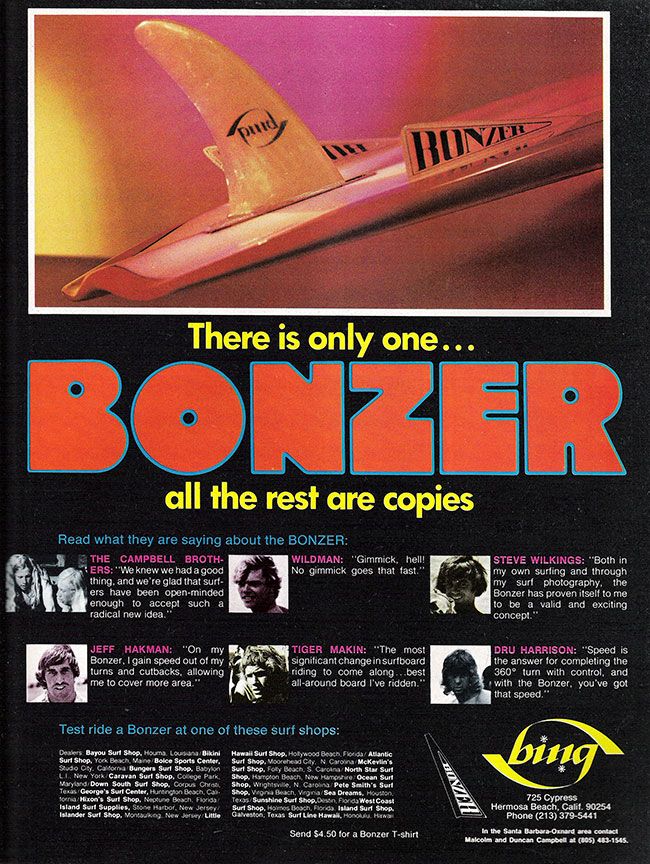
Ahora estamos en una revolución de los materiales a la hora de construir tablas, ¿cuál crees que prosperará?
El único material nuevo que he visto en diez años es la resina bio epoxi y no es tan buena como la resina epoxi normal y además cuesta más, no durará hasta que puedan hacerla tan buena y a un precio tan razonable.
Seguís haciendo tablas al estilo tradicional, a mano ¿al final es una forma de trabajar más versátil?
Me gusta mucho hacer tablas a mano y sí, es la forma más versátil de hacer tablas, aunque también un trabajo duro y lento.
En 2007 cuando te asociaste a Bing, ¿qué ideas traías?
Coger diseños antiguos y actualizarlos.
¿Qué elementos debería valorar una persona a la hora de encargar una tabla de surf?
Averiguar qué es exactamente lo que necesita asesorado por el shaper o el comercial experto mediante un diálogo personal con el cliente.

El proceso de fabricar un nuevo modelo de tabla tiene que pasar por diferentes fases, ¿nos podrías explicar en qué consiste y sus dificultades?
Lo primero es el concepto y luego hacer prototipos hasta que consigues uno de la manera que te gusta, esto puede llevar desde una tabla hasta 40 y mucho tiempo.
En general se ve que la forma de construir tablas es más abierta que hace unos años, lo que ha permitido recuperar modelos antiguos, ¿qué modelos de tablas (me refiero a pigs, mini simmons, etc.) han sido más complicadas de “actualizar”?
Hay muchos modelos y conceptos que hemos estado actualizando, la más reciente es la serie Pig Performers. Hicimos el Alfa Pin y la Omega Square Tail que viene de los primeros shortboards de finales de los 60.

Strand shop 1959
Muchas de las tablas que se recuperan conllevan un estilo de surfing muy particular y, en muchos casos, olvidado, ¿es una forma de recuperar otra forma de “ver” el mar?
Sí, estas tablas, definitivamente, dibujan líneas diferentes a lo que ha sido popular. Creo que hay que volver a la época para entender realmente cómo montarlas correctamente, mucha gente las compra y les lleva algún tiempo entenderlas.
¿Qué tabla de surf ha sido más difícil de actualizar?
La más difícil es un shortboard single fin de menos de 7’0″ porque carecen de la superficie para ir lo suficientemente rápido para trabajar correctamente.

Surfer Mag. Julio 1964
Al final, recuperar modelos antiguos es una especie de arqueología , no solo de las formas, también implican otra forma de relacionarnos con las olas…
Sí, durante muchos años, de 1968 a 1976, esas tablas eran muy difíciles de manejar, así que hay que tener cuidado de seleccionar los elementos que funcionaban y dejar atrás los que no. Una vez que el surf competitivo volvió en 1978, realmente comenzó a avanzar el diseño y la tabla comenzó a disminuir de tamaño. Entonces empezaron a aparecer múltiples quillas y el surf cambió drásticamente.
Es difícil decir cuál es tu hijo favorito, pero ahora mismo, ¿Cuál es tu tabla favorita de Bing?
La cola cuadrada del Pigformer porque atrapa las olas muy fácilmente y funciona en muchas condiciones diferentes, especialmente en olas blandas.
www.bingsurf.com
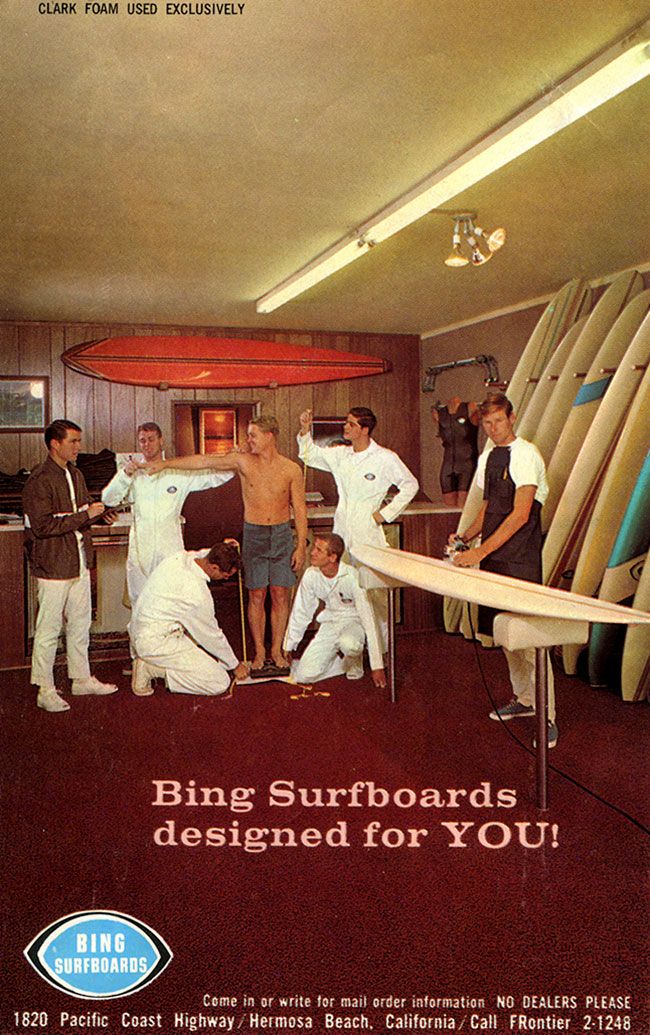
Surfer Magazine. Marzo 1965
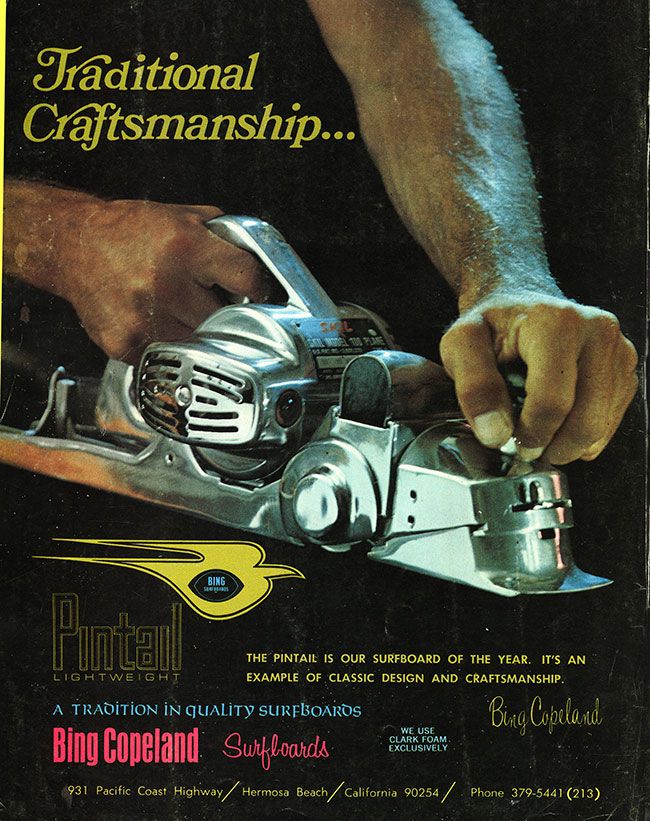
Surfing Magazine. Junio 1968

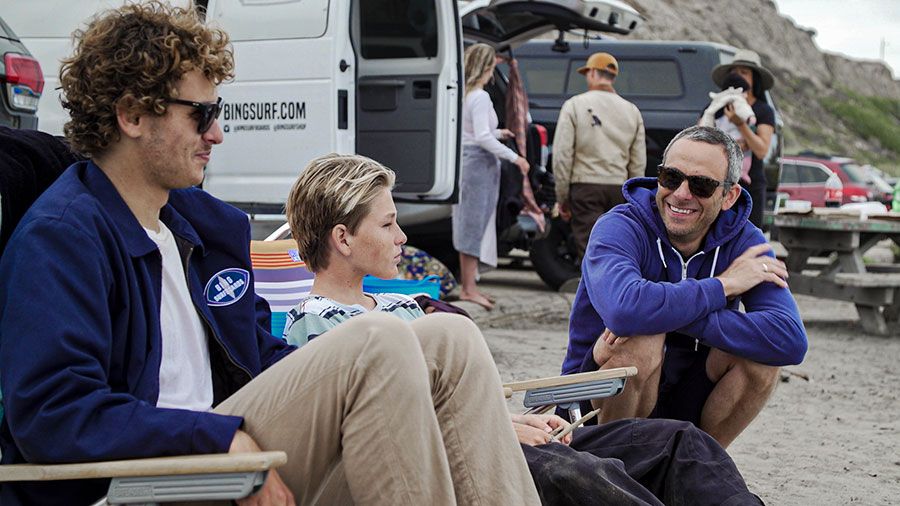





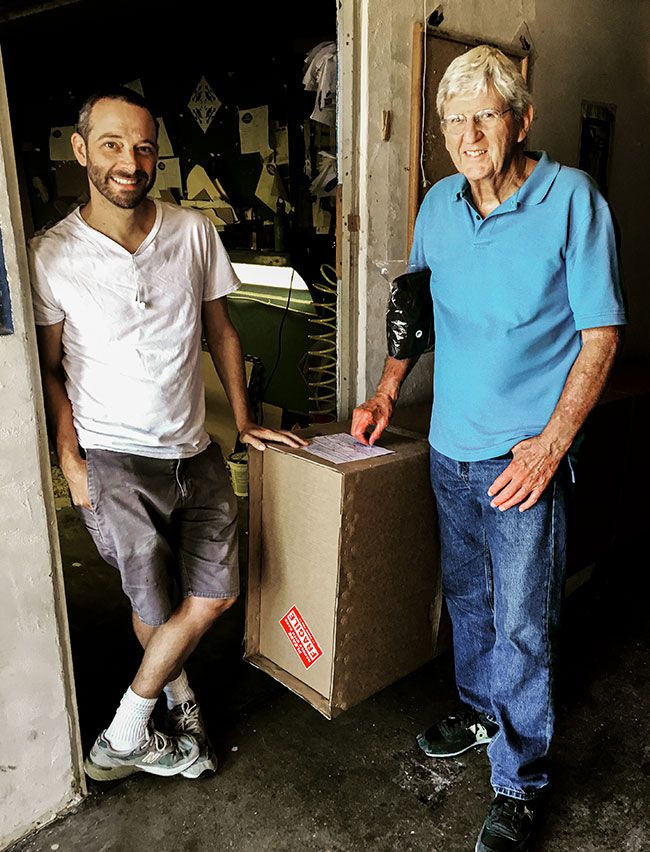




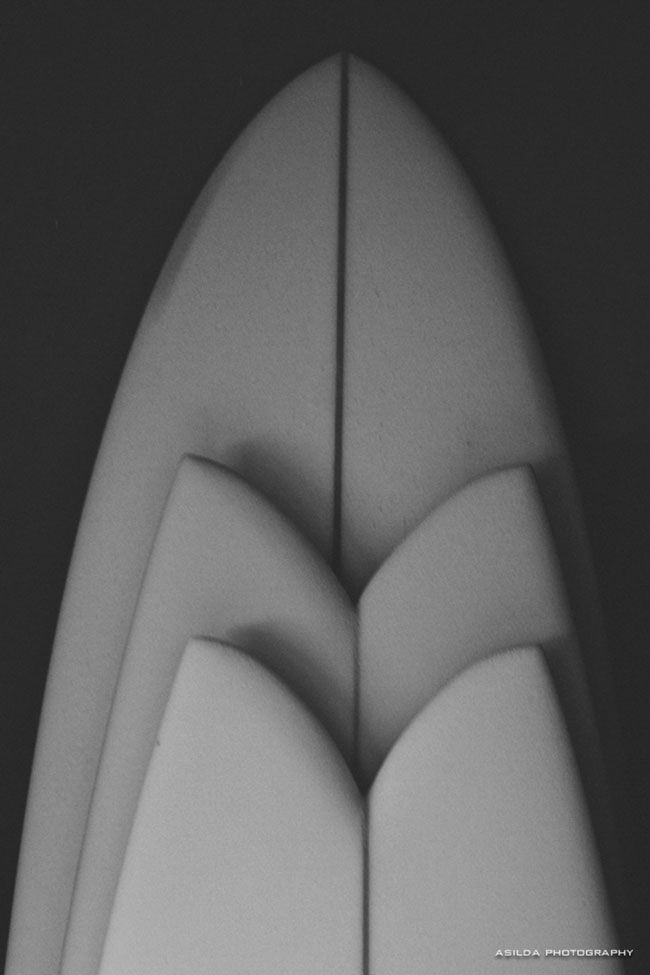







English:
BING. 60 YEARS ON THE BEACH
Bing is the quintessential California surf brand. Of course for many of us it is the representation of California surfing and its history. The most charismatic and recognizable shapers and surfers of the surf culture have passed through Bing.
On the occasion of this anniversary we took the opportunity to interview Matt Calvani , shaper of Bing. From his head have come out the most interesting board models of the last decade and has made Bing continue to be synonymous with quality in their creations.
In this situation of global pandemic how do you think it will affect an industry so linked to leisure as is the surfing?
Since beaches are closed “some beaches in San Diego started to open up”. I think people are going to appreciate the ocean more and surf more. I also think people are going to be working from home permanently and will have more time to surf. Then there is more stress on people, surfing is a great stress reliever.
On a personal level, many see this crisis as an opportunity to become aware of environmental issues. Do you think that a critical awareness can occur?
Maybe, I think any kind of change comes from people that are absolutely committed to making change, people like Jesus and Mahatma Gandhi made huge social change with non violence. I don’t want government making or enforcing those decisions for me. I see the inefficacy of government with what’s going on with Covid 19 on all levels. What are waiting for make the change yourself.
Bing represents that line of connection with classic surfing. After 60 years, what is it that still attracts people from that style of surfing?
I think now more than ever it makes people think of a simpler time with more style and slower pace of life.
The Campbell brothers were important in the 1970s. In perspective, what did the bonzer bring to surfing?
First of all it was the first production tri fin to be made. At the time it was a very technical advanced boards that worked very good, especially in powerful waves, and since they have a strong presence currently it shows how credible the design has been over time.
Whenever we think about California, it is inevitable that the counterculture movement comes to mind and how it merged with the idea of freedom in surfing, could we think that surfing is one of the legacies of the Californian counterculture?
Surfing has always been counterculture, even back in the 1930’s, lots of people wanted to make surfboards so they wouldn’t need to get a real job.
The Bing catalogue is wide and covers a large range of boards. How is the process to include a new board in the catalogue?
Most of the time we make new models to to add fresh idea to the brand as the trend in surfing changes. We sometimes help make changes to the trends in surfing by making a board that people haven’t seen yet.
It’s been 60 years since Bing was created and right now it’s a global brand. At what point is the brand?
I think anyone that has their own logo put on a board is already a brand, now a global brand that takes a lot of years.
What business decisions have you made to stay on top for so long?
Constant change and innovation, good quality, good colors, at a fair price.
In your youth, what drove you to start shaping boards?
I didn’t want to get a real job, see above.
With the latest technological advances how do you think the board shaping profession has changed in recent years?
I don’t see any advancements in shaping in recent years, the CNC machines and pop out technology in Asia have been around for 30 years. Nothing new under the sun.
We are now in a revolution of the materials when it comes to shaping boards, which one do you think will prosper?
The only new materials I’ve seen in ten years is bio epoxy resin and it’s not as good as the regular epoxy resin and it costs more, it won’t last until they can make is as good and as reasonably priced.
Do you still shape boards in the traditional style, by hand…do you think that, in the end, is a more versatile way of working?
I really enjoy making boards by hand and yes it’s the most versatile way of making boards, it’s just slow hard work.
In 2001 when you joined Bing, what ideas did you have?
To take old designs and update them.
What elements should a person value when ordering a surfboard?
Finding out from the shaper or a knowledgeable sales person exactly what they need through a personal dialog with the customer.
The process of making a new board model has to go through different phases. Could you explain to us what it consists of and its difficulties?
First is the concept and then making prototypes until you get one the way you like it, this can take anywhere from one board to 40 boards and lot of time.
In general you can see that the way of building boards is now more open than a few years ago, which has allowed to recover old models of boards. What models of boards (I mean pigs, mini simmons, etc.) have been more complicated to “update”?
There’s many models and concept we have been updating most recently the Pig Performers series is most recent. We did the Alpha Pin and the Omega square tail that comes from the first shortboards in the late 60’s.
I think that many boards that are recovered, carry a very particular style of surfing and in many cases this style has been forgotten, is it a way to recover another way of “seeing” the sea?
Yes these boards definitely draw different lines that are different then what’s been popular. I feel you need to go back to the era to really understand how to ride them properly, lots of people buy then and it takes them some time to figure them out.
Which surfboard has been more difficult to update?
The hardest is a single fin shortboards under 7’0″ because they lack the surface area to go fast enough to work properly.
In the end recovering old models is a kind of archaeology, not only of the forms but also bring another way to relate to the waves …
Yes, for a lot of the years from 1968 to 1976 those boards were really hard to ride, so you have to be careful to take the right elements that worked and leave the elements that don’t.
Once competitive surfing came back in 1978 it really started to advance design and board started dropping in size. Then multiple fins started coming around and really changed surfing dramatically.
It’s hard to say which is your favorite, but right now what is your favorite board of Bing?
The Pigformer square tail because it catches waves really easy and it works in so many different conditions especially mushy waves.